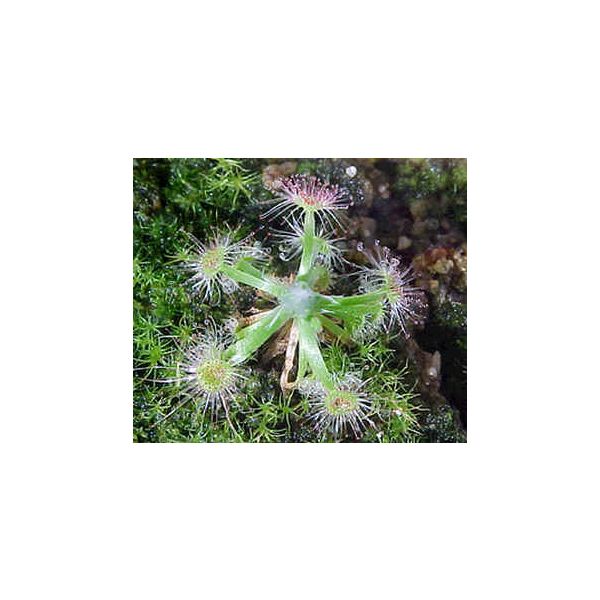Drosera Androsaceae Seeds (Cone Sundew) (Pygmy)
Drosera Androsaceae Seeds (Cone Sundew) (Pygmy)
Another startling feature of the Pygmy Sundews are their size. Normally the plants grow to a maximum diameter of half an inch. Although some people are put off by their size, their beauty lie in numbers.
Availability: Out of stock
SKU
Drosera Androsaceae
Drosera androsacea, the Cone Sundew is a pygmy Drosera endemic from Western Australia.
This perrenial is forming flat open rosettes, up to 8 mm in diameter. The flowers are white or pink, with purplish veins. It flowers in September and October.
It 's an insectivorous plant, it can survive in nitrogen poor soils because it gets the nutrients it needs from insects. The upper surfaces of leaves are covered with hairs that secrete a sweet sticky substance. This attracts insects, which become smeared with it and unable to escape. The plant then exudes a digestive fluid that enables it to absorb most of the insect into its system.
Another startling feature of the Pygmy Sundews are their size. Normally the plants grow to a maximum diameter of half an inch. Although some people are put off by their size, their beauty lie in numbers. Because of the gemmae, the plants quickly cover the growing area, forming dense mats of red-green leaves. The leaves, curl around any captured prey like a fist.
Pygmy Sundews differ from the rest of their species, because of their ability to form gemmae. These are flat, round bodies which form in the center of the plant. They are basically seed, although they don't need to be pollinated. The germination rate is far higher than that of seed. Also gemmae grow into mature plants very quickly.
Because of the plants producing lots of gemmae, these plants are very easy to grow and propagate. When the plants are forming gemmae, brush the gemmae off with a soft paintbrush onto a paper towel. Even if you don't want any new plants it is best to do this, because if you don't your plants will become over crowded and become and easy target for pests.
Hardiness zones 8-10, (-10øC/15øF, 1øC/35øF) in Winter. The plants should have hot and dry Summers and cool and wet Winters. They should be grown in bright light, but with protection from full midday sun. Temperatures should be kept between 20øC/68øF, 25øC / 80øF. In cloudy coastal areas, artificial light is a must.
Drosera androsacea grows in stony, sandy loam or clayey soils, in the middle of brush-wood. Drosera androsacea have very long roots and grow best in pots 15-20 cm deep. Use a standard peat moss/sand which can be anything from 30% to 100% peat moss. There's no need to fertilize, as the plant relies on insects for food.
Requires consistently moist soil in Winter; do not let dry out between waterings. During Summer the plant becomes dormant and should be given just enough water to keep the lower half of the pot damp while the top half is kept dry. Water must be distilled or rain water because they do not tolerate city or hard water.
| Common name | Cone Sundew |
|---|---|
| Species | Drosera androsaceae |
| Germination | The seeds require 6 weeks hot stratification. Sow directly on the surface of your moist but not soaked soil mix. Do not cover them with any medium, the seeds are really tiny. After hot stratification, somewhat uncover the top of the pot, so that moisture and heat drop a little. Place the pot in an area with real nice strong light and keep the temperature around 20øC/68øF. When you see some tiny plants starting to sprout, slowly open the top of the pot, a little each day, so that the new seedlings don't go into shock from the humidity being lowered too quickly. After hot stratification, germination usually occurs in 1-3 months, but it can be prolonged up to several months, depending on their degree of unbroken dormancy, don't give up. Be very gentle with the new seedlings, not to destroy anything, it is very tiny. Make sure that it gets good air circulation. |
| Scarification / Stratification | It creates a hot and moist environment for the seeds. This will break their dormancy. Place the seeds on top of a prepared soil mix. Put the pots with seeds in plastic ziplock bags under but not too close to florescent lights. A temperature around 25øC / 76øF works best. Make sure to check the seeds often. If fungus or mold appears treat it with a fungicide. |
| Price View | Price Range |

